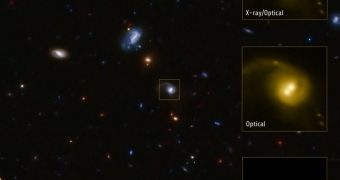Harvard-Smithsonian Center for Astrophysics (CfA) experts announce the discovery of a weird object in space, which appears to be a black hole currently being cast out of its host galaxy. The massive cosmic structure is traveling extremely fast.
Astronomers estimate that its speed may reach several million miles per hour, and say that there is no way of knowing whether or not it will remain constant. The black hole was identified using the NASA Chandra X-ray Observatory, which is very well suited for such investigations.
Evidence collected thus far appears to indicate that the object collided and merged with another black hole. This led to the creation of large amounts of gravitational wave radiation, which significantly altered its original trajectory and speed.
Scientists interpret the results of their observations as implying that Albert Einstein was correct in hypothesizing that gravitational waves can indeed influence their surroundings by a significant margin. They are believed to be distortions in the fabric of spacetime.
These waves are produced by interacting neutron stars or black holes, as well as by other large-scale cosmic events. Several missions aimed at detecting such gravitational waves are currently in the works.
“It's hard to believe that a supermassive black hole weighing millions of times the mass of the Sun could be moved at all, let alone kicked out of a galaxy at enormous speed,” CfA expert and study leader, Francesca Civano, explains.
“But these new data support the idea that gravitational waves – ripples in the fabric of space first predicted by Albert Einstein but never detected directly – can exert an extremely powerful force,” she goes on to say.
Another important implication of this research is that many massive black holes may currently be roaming the space between galaxies, something that was thought to be very unlikely until now.
These objects would be completly undetectable, CFA investigators and study coauthor Laura Blecha explains. Over the eons, they would consume all gas surrounding them, leaving no traceable sign of their passing.
The new study was conducted using the High Resolution Camera aboard Chandra. The instrument was pointed directly at CID-42, a system in the middle of a distant galaxy, some 4 billion light-years away.
“The previous [Hubble] data told us that there was something special going on, but we couldn't tell if there were two black holes or just one. We needed new X-ray data to separate the sources,” CFA expert and study coauthor, Martin Elvis, adds.
Details of the new study will be published in the June 10 issue of the esteemed Astrophysical Journal.

 14 DAY TRIAL //
14 DAY TRIAL //